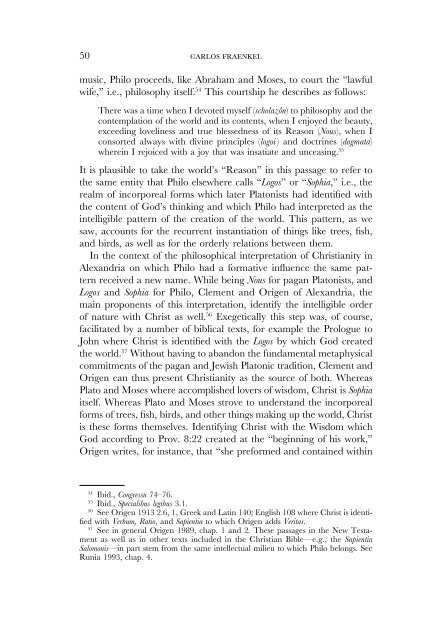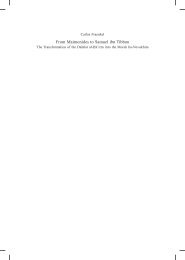50 carlos fraenkelmusic, Philo proceeds, like Abraham and Moses, to court the “lawfulwife,” i.e., philosophy itself. 54 This courtship he describes as follows:There was a time when I devoted myself (scholazôn) to philosophy and thecontemplation of the world and its contents, when I enjoyed the beauty,exceeding loveliness and true blessedness of its Reason (Nous), when Iconsorted always with divine principles (logoi ) and doctrines (dogmata)wherein I rejoiced with a joy that was insatiate and unceasing. 55It is plausible to take the world’s “Reason” in this passage to refer tothe same entity that Philo elsewhere calls “Logos” or “Sophia,” i.e., therealm of incorporeal forms which later Platonists had identified withthe content of God’s thinking and which Philo had interpreted as theintelligible pattern of the creation of the world. This pattern, as wesaw, accounts for the recurrent instantiation of things like trees, fish,and birds, as well as for the orderly relations between them.In the context of the philosophical interpretation of Christianity inAlexandria on which Philo had a formative influence the same patternreceived a new name. While being Nous for pagan Platonists, andLogos and Sophia for Philo, Clement and Origen of Alexandria, themain proponents of this interpretation, identify the intelligible orderof nature with Christ as well. 56 Exegetically this step was, of course,facilitated by a number of biblical texts, for example the Prologue toJohn where Christ is identified with the Logos by which God createdthe world. 57 Without having to abandon the fundamental metaphysicalcommitments of the pagan and Jewish Platonic tradition, Clement andOrigen can thus present Christianity as the source of both. WhereasPlato and Moses where accomplished lovers of wisdom, Christ is Sophiaitself. Whereas Plato and Moses strove to understand the incorporealforms of trees, fish, birds, and other things making up the world, Christis these forms themselves. Identifying Christ with the Wisdom whichGod according to Prov. 8:22 created at the “beginning of his work,”Origen writes, for instance, that “she preformed and contained within54Ibid., Congressu 74–76.55Ibid., Specialibus legibus 3.1.56See Origen 1913 2.6, 1, Greek and Latin 140; English 108 where Christ is identifiedwith Verbum, Ratio, and Sapientia to which Origen adds Veritas.57See in general Origen 1989, chap. 1 and 2. These passages in the New Testamentas well as in other texts included in the Christian Bible—e.g., the SapientiaSalomonis—in part stem from the same intellectual milieu to which Philo belongs. SeeRunia 1993, chap. 4.
concept and history of philosophical religions 51herself the species and models of all creation.” 58 In another passage,Origen borrows Philo’s image of the architect to illustrate the formationof the intelligible world. 59 But how does Christ as God’s Logos relateto the embodied Christ of the Gospels? The shortest chapter in Periarchôn (On First Principles), Origen’s chief theological work, clearlybears witness to his puzzlement about the doctrine of incarnation. 60The explanation he suggests is that as a human being Christ had a“human and rational soul (humana et rationabilis anima)” whose nature“is the same as that of all other souls.” 61 In this sense, Christ is merelyone of the “rational creatures” who in differing degrees have part inChrist the Logos, depending on the strength of their love for him. 62The difference is that the soul of Christ is more perfectly united withthe intelligible world—i.e., with Christ the Logos—on account “of [hissoul’s] perfect love” and as “the reward of its virtues.” 63 None “of theother souls that descended into human bodies had a pure and genuineimage (similitudo) of the archetype [i.e., the Logos] in it.” In other words:The soul of the embodied Christ is, according to Origen, more virtuousthan any other soul; it is driven by a greater intellectual love of Godthan any other soul. As a consequence it is more perfectly united withthe Logos than any other soul. But while this makes the embodied Christinto the greatest philosopher of all times who on a scale of perfectioncomes out at the top, his soul is not fundamentally different from otherrational souls. It surpasses them in degree, not in essence. 64 Concerning58Origen 1913 1.2, 3, Greek and Latin 30; English 16; cf. also the end of 1.2, 2.59See the discussion of archê in Origen 1989 1.23.60Origen 1913 2.6, 1, Greek and Latin 140; English 108–109; 2.6, 2, Greek andLatin 141; English 109–110. See also the expression of uncertainty concerning thedoctrine in ibid. and the suggestion of its preliminary character in 2.6, 7, Greek andLatin 147; English 114–115.61Ibid. 2.6, 4, Greek and Latin 144–145; English 112–113.62Ibid. 2.6, 3, Greek and Latin 141–142; English 110.63Ibid. 2.6, 4, Greek and Latin 143; English 111–112.64This is, of course, a controversial reading. Origen’s Christology was and continuesto be a battlefield. See e.g., the first five accusations to which Pamphilus of Caesarearesponds in 2002, 88–121, in particular the third. But I cannot find strong textualevidence in 2.6 that for Origen the unity of Christ’s soul with Christ as the Logosmeans identity. As we saw above, he claims that Christ’s soul contains a “pure andgenuine image” of the Logos. Elsewhere he describes their relation as that of a shadowto a body, or of iron heated in fire to fire, or of a vessel to oil. Concerning the unionof Christ’s soul with the Logos he says that they “are more in one flesh than man andwoman” (Origen 1913 2.6, 3, Greek and Latin 143; English 111); cf. Matt. 19:5–6.With reference to 1 Cor. 6:17, moreover, he compares this union to the union attainedwith Christ by those who “imitate” him. All this suggests that Christ’s soul and the Logos



